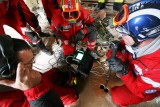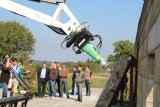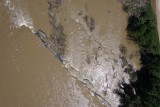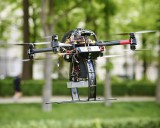ICARUS UAV operational deployment presented at the INSARAG Team Leaders Meeting
ICARUS UAV operational deployment presented at the INSARAG Team Leaders Meeting
Representatives of the ICARUS project participated in the INSARAG (International Search and Rescue Advisory Group) Team Leaders meeting, which took place between the 22nd and the 24th of October 2014, in Doha, Qatar. More than 120 participants from 40 different countries were present at the three-day annual event, which provides an opportunity for leaders of international Search and Rescue (SAR) teams to discuss the latest developments, operational procedures and technological capabilities in the SAR domain.
In their presentation, the ICARUS consortium members showcased the deployment of an Unmanned Aerial System (UAS) to flood-affected parts of Bosnia-Herzegovina in May/June of 2014, demonstrating the robotic device was used in a real-life crisis in order to support SAR personnel.
Haris Balta, a Researcher from the Royal Military Academy of Belgium (RMA), which coordinates the ICARUS project, used a Microdrone MD4-1000 quadrotor to assist the B-FAST (Belgian First Aid and Support Team) in undertaking tasks such as aerial inspection, mapping and dyke breach detection. Several important lessons learned concerning the procedural, legal and logistical aspects of integrating UAS into the toolset of SAR teams were conveyed to the audiance.
Mr Balta also assisted the Bosnia-Herzegovina Mine Action Centre (BHMAC), using the UAS to help in detecting the possible new locations of landmines which had been displaced by landslides caused by the floods.
The audience’s response to the ICARUS presentation was very positive as many teams already experimenting with UAS tools wanted to learn more about the practicalities of utilising such devices in real-life situations. ICARUS consortium members demonstrated that it was possible to mount an international immediate crisis response operation using a UAV, despite the complex legal and logistical aspects of carrying out such operations at the international level.
Representatives of the ICARUS project participated in the INSARAG (International Search and Rescue Advisory Group) Team Leaders meeting, which took place between the 22nd and the 24th of October 2014, in Doha, Qatar. More than 120 participants from 40 different countries were present at the three-day annual event, which provides an opportunity for leaders of international Search and Rescue (SAR) teams to discuss the latest developments, operational procedures and technological capabilities in the SAR domain.
In their presentation, the ICARUS representatives showcased the deployment of an Unmanned Aerial System (UAS) to flood-affected parts of Bosnia-Herzegovina in May/June of 2014, explaining how the robotic device was used in a real-life crisis in order to support SAR personnel.
Haris Balta, a Researcher from the Royal Military Academy of Belgium (RMA), which coordinates the ICARUS project, used a Microdrone MD4-1000 quadrotor carrying a special purpose sensor suite to assist the B-FAST (Belgian First Aid and Support Team) in undertaking tasks such as aerial inspection, mapping and dyke breach detection. Several important lessons learned concerning the procedural, legal and logistical aspects of integrating UAS into the toolset of SAR teams were conveyed to the audience.
Mr Balta also assisted the Bosnia-Herzegovina Mine Action Centre (BHMAC), using the UAS to help in detecting the possible new locations of landmines which had been displaced by landslides caused by the floods.
The audience’s response to the ICARUS presentation was very positive as many teams having already experimented with UAS tools wanted to learn more about the practicalities of utilising such devices in real-life situations. ICARUS consortium members demonstrated that it was possible to mount an international immediate crisis response operation using a UAV, despite the complex legal and logistical aspects of carrying out such operations.
- Login to post comments














